Content for TS 23.502 Word version: 19.2.0
1…
4.2.2.2.2
4.2.2.2.3…
4.2.2.3…
4.2.3…
4.2.3.3
4.2.4…
4.2.6
4.2.7…
4.2.9…
4.2.11…
4.2.11.5…
4.3…
4.3.2.2.2
4.3.2.2.3…
4.3.3…
4.3.3.3
4.3.4…
4.3.4.3
4.3.5…
4.3.5.2…
4.3.5.4…
4.3.5.6…
4.3.6…
4.4…
4.5…
4.9…
4.9.1.3…
4.9.2…
4.11…
4.11.1…
4.11.1.2.2
4.11.1.2.3
4.11.1.3…
4.11.1.3.3…
4.11.1.4…
4.11.1.5…
4.11.2…
4.11.3…
4.12…
4.12.6…
4.12a…
4.12b…
4.13…
4.13.4…
4.13.6…
4.14…
4.15…
4.15.3.2.5…
4.15.4…
4.15.6…
4.15.6.7…
4.15.6.13…
4.15.6.14…
4.15.9…
4.15.9.4…
4.15.13…
4.15.13.4…
4.16…
4.16.4…
4.16.8…
4.16.11…
4.16.14…
4.16.15…
4.17…
4.17.9…
4.18…
4.19…
4.22…
4.23…
4.23.7…
4.23.7.3.3
4.23.7.3.4…
4.23.9…
4.23.9.4…
4.23.11…
4.24…
4.25…
4.25.6…
4.26…
5…
5.2.3…
5.2.5…
5.2.6…
5.2.7…
5.2.8…
5.2.9…
5.2.12…
5.2.18…
A…
E…
F…
G
H…
4.16.11 UE Policy Association Establishment
4.16.12 UE Policy Association Modification
4.16.12.1 UE Policy Association Modification initiated by the AMF
4.16.12.1.1 UE Policy Association Modification initiated by the AMF without AMF relocation
4.16.12.1.2 UE Policy Association Modification with old PCF during AMF relocation
4.16.12.2 UE Policy Association Modification initiated by the PCF
4.16.13 UE Policy Association Termination
4.16.13.1 AMF-initiated UE Policy Association Termination
4.16.13.2 PCF-initiated UE Policy Association Termination
...
...
4.16.11 UE Policy Association Establishment p. 541
4.16.11.1 General |R17| p. 541
The UE Policy Association Establishment procedure, which may be performed for a UE registered in the same AMF or different AMFs for 3GPP access and non-3GPP access, concerns the following scenarios:
- UE initial registration with the network.
- The AMF relocation with PCF change in handover procedure and registration procedure.
- UE registration with 5GS when the UE moves from EPS to 5GS and there is no existing UE Policy Association between AMF and PCF for this UE.
- A change of the value of the UE Policy Association indicator received from UDM from "disabled" to "enabled" while the UE is registered.
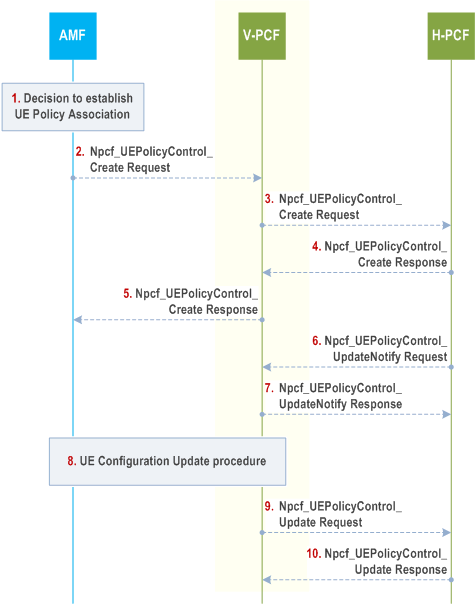
This procedure concerns both roaming and non-roaming scenarios. The AMF stores the UE Policy Container in the UE Context when received from the UE.
In the non-roaming case the V-PCF is not involved and the role of the H-PCF is performed by the PCF. For the roaming scenarios, the V-PCF interacts with the AMF and the H-PCF interacts with the V-PCF:
Step 1.
The AMF establishes UE Policy Association with the (V-)PCF considering the value of the UE Policy Association Indicator from UDM, the reception of the UE Policy Container from the UE and the AMF local configuration as defined in clause 6.1.2.2.5 of TS 23.503.
Step 2.
The AMF sends a Npcf_UEPolicyControl Create Request with the following information: SUPI, may include Access Type and RAT, PEI, ULI, UE time zone, Serving Network (PLMN ID, or PLMN ID and NID, see clause 5.34 of TS 23.501), the Internal-Group-ID-list and UE Policy Container (the list of stored PSIs, operating system identifier, Indication of UE support for ANDSP, indication of UE capability of reporting URSP rule enforcement to network, indication of support of URSP delivery in EPS). In roaming scenario, based on operator policies, the AMF may provide to the V-PCF the PCF ID of the selected H-PCF. The V-PCF contacts the H-PCF. In roaming case, steps 3 and 4 are executed, otherwise step 5 follows.
If the AMF, based on configuration, is aware that the UE is accessing over a gNB using satellite backhaul, the AMF includes the Satellite backhaul category as described in clause 5.43 of TS 23.501.
If during UE initial registration the AMF receives from the UE the indication of support of N3IWF selection based on the slices the UE wishes to use over untrusted non-3GPP access and/or of UE support for TNGF selection based on the slices the UE wishes to use over trusted non-3GPP access, the AMF shall indicate to the PCF that the UE supports N3IWF selection based on the slices the UE wishes to use over untrusted non-3GPP access and/or UE support for TNGF selection based on the slices the UE wishes to use over trusted non-3GPP access. The AMF may request to the PCF to receive a notification when the provisioning in the UE of ANDSP/WLANSP with slice information has finished.
Step 3.
The V-PCF forwards the information received from AMF in step 2 to the H-PCF. When a UE Policy Container is received at initial registration, the H-PCF may store the PEI, the OSId, indication of UE capability of reporting URSP rule enforcement to network, indication of support of URSP delivery in EPS or the indication of UE support for ANDSP in the UDR using Nudr_DM_Create including DataSet "Policy Data" and Data Subset "UE context policy control data".
The H-PCF may invoke the Nudr_DM_Query service to the UDR. And the UDR may response with the requested policy control subscription data as in clause 6.2.1.3 of TS 23.503 and/or application data as in clause 6.2.1.6 of TS 23.503.
The V-PCF may retrieve the Application guidance on URSP Rule for inbound roamers of the PLMN of the SUPI, if not available, using Nudr_DM_Query or Nudr_DM_Subscribe including the Data Set "Application Data" and Data Subset "Service Specific Information" and DataKey set to "PLMN ID(s) of inbound roamers".
Step 4.
The H-PCF sends a Npcf_UEPolicyControl Create Response to the V-PCF. The H-PCF may provide the Policy Control Request Trigger parameters in the Npcf_UEPolicyControl Create Response. Before sending the response, the H-PCF may determine that the decision about UE policy control depends on the status of the policy counters available at the CHF and if such reporting is not established for the subscriber, the H-PCF initiates an Initial Spending Limit Report Retrieval as defined in clause 4.16.8.2. If policy counter status reporting is already established for the subscriber and the H-PCF determines that the statuses of additional policy counters are required, the H-PCF initiates an Intermediate Spending Limit Report Retrieval as defined in clause 4.16.8.3.
The (H-)PCF in roaming and the PCF in non-roaming may register to the BSF as the PCF serving this UE, if not already registered at the AM Policy Association establishment. This is performed by using the Nbsf_Management_Register operation, providing as inputs the UE SUPI/GPSI and the PCF identity.
Step 5.
The (V-) PCF sends a Npcf_UEPolicyControl Create Response to the AMF. The (V-)PCF relays the Policy Control Request Trigger parameters in the Npcf_UEPolicyControl Create Response.
The (V-)PCF also subscribes to notification of N1 message delivery of policy information to the UE using Namf_Communication_N1N2MessageSubscribe service which is not shown in this figure.
Step 6.
The (H-)PCF gets policy subscription related information and the latest list of PSIs from the UDR using Nudr_DM_Query service operation (SUPI, Policy Data, UE context policy control data, Policy Set Entry) if either or both are not available and makes a policy decision. The (H-)PCF may get the PEI, the OSId, indication of UE capability of reporting URSP rule enforcement to network or the indication of UE support for ANDSP in the UDR using Nudr_DM_Query including DataSet "Policy Data" and Data Subset "UE context policy control data" if the AMF relocates and the PCF changes. In the roaming scenario, the H-PCF may provide the indication of UE support for ANDSP to the V-PCF, if the indication was not present in the Npcf_UEPolicyControl Create request from V-PCF and the H-PCF gets this information from the H-UDR. The (H-)PCF may get the 5G VN group data and 5G VN group membership for each Internal-Group-ID received from the AMF using Nudr_DM_Query (Internal-Group-Id, Subscription Data, 5G VN Group Configuration). The (H-)PCF may store the 5G VN group data and 5G VN group membership for later use for other SUPIs that belong to the same Internal-Group-ID. The (H-)PCF may request notifications from the UDR on changes in the subscription information by invoking Nudr_DM_Subscribe (Policy Data, SUPI, DNN, S-NSSAI, Notification Target Address (+ Notification Correlation Id), Event Reporting Information (continuous reporting), UE context policy control data) service. The (H-)PCF may request notifications from the UDR on changes in the 5G VN group data or 5G VN group membership associated to each of the Internal-Group-Id provided to the PCF by invoking Nudr_DM_Subscribe (Subscription Data, 5G VN Group Configuration, Internal Group ID, Notification Target Address (+ Notification Correlation Id), Event Reporting Information (continuous reporting)) service. The (H-)PCF creates the UE policy container including UE policy information as defined in clause 6.6 of TS 23.503 and in the case of roaming H-PCF provides the UE policy container in the Npcf_UEPolicyControl_UpdateNotify Request. In the non-roaming case, the PCF may subscribe to Analytics from NWDAF as defined in clause 6.1.1.3 of TS 23.503.
Step 7.
The V-PCF sends a response to H-PCF using Npcf_UEPolicyControl_UpdateNotify Response.
Step 8.
The (V-)PCF triggers UE Configuration Update Procedure in clause 4.2.4.3 to sends the UE policy container including UE policy information to the UE. The (V-)PCF checks the size limit as described in clause 6.1.2.2.2 of TS 23.503.
Step 9.
If the V-PCF received notification of the reception of the UE Policy container then the V-PCF forwards the notification response of the UE to the H-PCF using Npcf_UEPolicyControl_Update Request.
If the V-PCF is notified by the V-UDR about the Service Specific Information applicable to inbound roamers from the HPLMN of the UE as specified in clause 4.15.6.10, the V-PCF provides the Service Parameters to the H-PCF.
Step 10.
The H-PCF sends a response to the V-PCF. If the V-PCF received a UE Policy Container step 8 will follow.
4.16.12 UE Policy Association Modification p. 543
4.16.12.1 UE Policy Association Modification initiated by the AMF p. 543
4.16.12.1.1 UE Policy Association Modification initiated by the AMF without AMF relocation p. 543
This procedure addresses the scenario where a Policy Control Request Trigger condition is met.
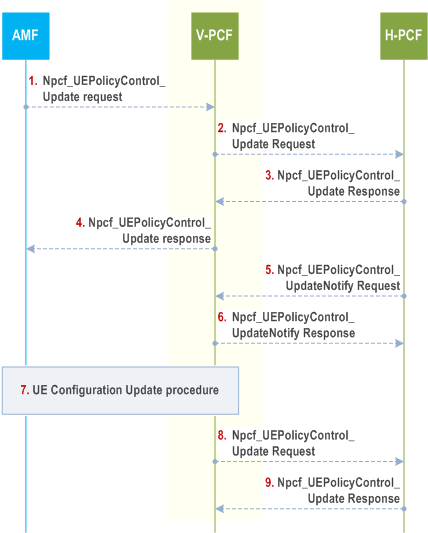
This procedure concerns both roaming and non-roaming scenarios.
In the non-roaming case the V-PCF is not involved. In the roaming case, the AMF interacts with the V-PCF and the H-PCF interacts with the V-PCF.
Step 1.
Steps 7, 8 and 9 are the same as steps 8, 9 and 10 of procedure UE Policy Association Establishment in clause 4.16.11.
When a Policy Control Request Trigger condition is met the AMF updates UE Policy Control Association and provides information on the conditions that have changed to the PCF. The AMF sends a Npcf_UEPolicyControl Update Request with the following information: UE Policy Association ID associated with the SUPI defined in TS 29.525 and the Policy Control Request Trigger met. In roaming scenario, based on operator policies, the AMF may provide to the V-PCF the PCF ID of the selected H-PCF. The V-PCF contacts the H-PCF.
See clause 6.1.2.5 of TS 23.503 and clause 4.2.3.2 of TS 29.525 for more details on Policy Control Request Trigger.
The AMF may indicate to the PCF that the UE supports N3IWF selection based on the slices the UE wishes to use over untrusted non-3GPP access and/or UE support for TNGF selection based on the slices the UE wishes to use over trusted non-3GPP access.
In the roaming case, steps 2 and 3 are executed, otherwise step 4 follows.
Step 2.
The V-PCF forwards the information received from AMF in step 1 to the (H-)PCF.
Step 3.
The H-PCF replies to the V-PCF. In the non-roaming case, the PCF may subscribe to Analytics from NWDAF as defined in clause 6.1.1.3 of TS 23.503.
Step 4.
The (V-) PCF sends a Npcf_UEPolicyControl Update Response to the AMF.
Step 5.
The (H-)PCF may create the UE policy container including UE policy information as defined in clause 6.6 of TS 23.503. In the case of roaming the H-PCF may include the UE policy container in the Npcf_UEPolicyControl_UpdateNotify Request.
Step 6.
The (V-)PCF sends a response to H-PCF using Npcf_UEPolicyControl_UpdateNotify Response.
Steps 7, 8 and 9 are the same as steps 8, 9 and 10 of procedure UE Policy Association Establishment in clause 4.16.11.
4.16.12.1.2 UE Policy Association Modification with old PCF during AMF relocation p. 545
This procedure addresses the scenario where a UE Policy Association Modification with the old PCF during AMF relocation.
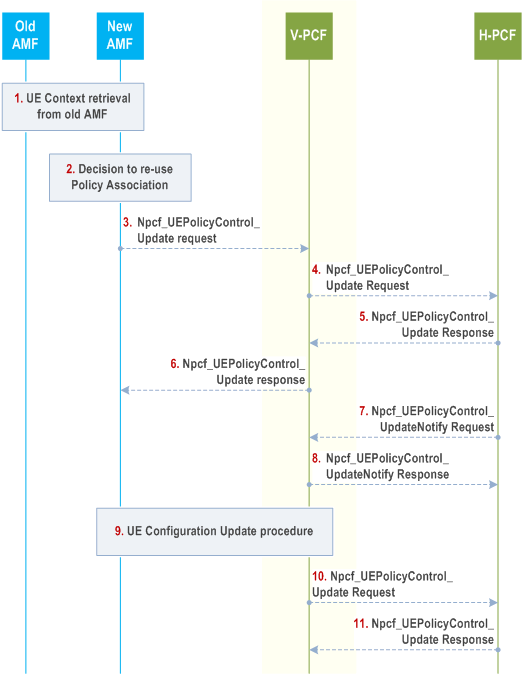
This procedure addresses both roaming and non-roaming scenarios.
In the non-roaming case the V-PCF is not involved. In the roaming case, the AMF interacts with the V-PCF and the V-PCF interacts with the H-PCF.
Step 1.
Steps 9, 10 and 11 are the same as steps 8, 9 and 10 of procedure UE Policy Association Establishment in clause 4.16.11.
[Conditional] When the old AMF and the new AMF belong to the same PLMN, the old AMF transfers to the new AMF the UE Policy Association information including policy control request trigger(s) and the PCF ID(s). For the roaming case, the new AMF receives both V-PCF ID and H-PCF ID.
Step 2.
Based on local policies, the new AMF decides to re-use the UE policy association for the UE Context with the (V-)PCF and contacts the (V)-PCF identified by the PCF ID received in step 1.
Step 3.
The new AMF sends Npcf_UEPolicyControl_Update to the (V-)PCF to update the UE policy association with the (V-)PCF. If a Policy Control Request Trigger condition is met, the information matching the trigger condition may also be provided by the new AMF.
In the roaming case, step 4 and 5 are executed, otherwise step 6 follows.
Step 4.
The V-PCF forwards the information received from new AMF in step 3 to the (H-)PCF.
Step 5.
The H-PCF replies to the V-PCF. In non-roaming case, the PCF may subscribe to Analytics from NWDAF as defined in clause 6.1.1.3 of TS 23.503.
Step 6.
The (V-)PCF updates the stored information provided by the old AMF with the information provided by the new AMF. The (V-)PCF sends a Npcf_UEPolicyControl Update Response to the AMF.
Step 7.
The (H-)PCF may create the UE policy container including UE policy information as defined in clause 6.6 of TS 23.503. In the case of roaming the H-PCF may include the UE policy container in the Npcf_UEPolicyControl_UpdateNotify Request.
Step 8.
The V-PCF sends a response to H-PCF using Npcf_UEPolicyControl_UpdateNotify Response.
4.16.12.2 UE Policy Association Modification initiated by the PCF p. 546
This procedure is used to update UE policy and/or UE policy triggers.
The H-PCF may interact with the CHF in HPLMN to make a decision about UE Policies based on spending limits.
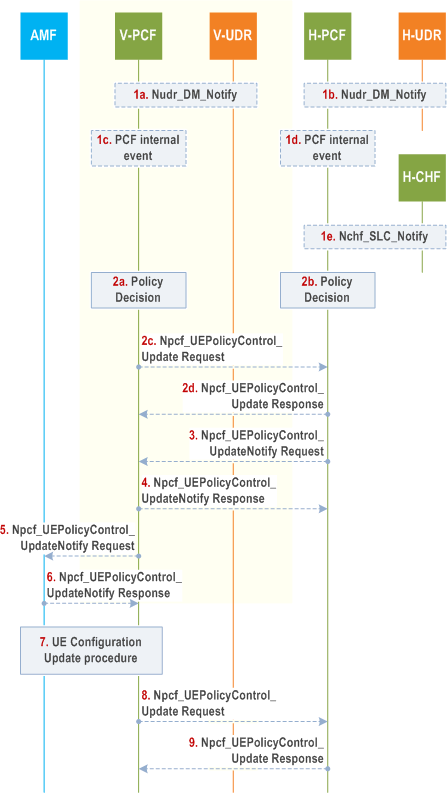
This procedure concerns both roaming and non-roaming scenarios.
In the non-roaming case the V-PCF is not involved and the role of the H-PCF is performed by the PCF. In the roaming case, the H-PCF provides UE policy decision and provides the policy to the AMF via V-PCF.
Step 1a and 1b.
If (H-)PCF subscribed to notification of subscriber's policy data change or 5G VN Group Configuration (5G VN group data, 5G VN group membership) change and a change is detected, the UDR notifies that the subscriber's policy data of a UE or 5G VN Group Configuration (5G VN group data, 5G VN group membership) has been changed.
The UDR notifies the (H-)PCF of the updated policy control subscription information profile via Nudr_DM_Notify (Notification correlation Id, Policy Data, either UE context policy control data or Policy Set Entry data or both, SUPI), or
The UDR notifies the (H-)PCF of the updated 5G VN Group Configuration (5G VN group data, 5G VN group membership) via Nudr_DM_Notify (Notification correlation Id, 5G VN Group Configuration, Internal-Group-Identifier), or
The (V-)UDR notifies the (V-)PCF of the updated policy control subscription information profile via Nudr_DM_Notify (Notification correlation Id, Policy Data, PolicySetEntry Data. PLMN ID).
The (V-)UDR notifies the (V-)PCF of the updated Service Parameters via Nudr_DM_Notify .
Step 1c and 1d.
PCF determines locally that UE policy information needs to be sent to the UE.
Step 1e.
The (H-)CHF notifies the (H-)PCF about the change of the status of the subscribed policy counters available at the (H-)CHF for that subscriber.
Step 2a and 2b.
The PCF makes the policy decision. If the group data is updated, the (H-) PCF checks the UE Policy Associations for those SUPIs within the Internal-Group-Id and may need to perform step 3 to step 9 for each UE Policy Association that needs to be updated with new UE Policies sent to each UE. In the non-roaming case, the PCF may subscribe to Analytics from NWDAF as defined in clause 6.1.1.3 of TS 23.503.
Step 2c and 2d.
In the roaming case, the V-PCF may provide the updated Service Parameters received from the V-UDR as specified in clause 4.15.6.10 to the H-PCF using the Npcf_UEPolicyControl_Update Request. The H-PCF sends a response to the V-PCF.
Step 3.
The (H-)PCF may create the UE policy container including UE policy information as defined in clause 6.1.2.2.2 of TS 23.503. In the case of roaming, the H-PCF may send the UE policy container in the Npcf_UEPolicyControl_UpdateNotify Request. The H-PCF may provide updated policy control triggers for the UE policy association. If there is the received Service Parameters from the V-PCF in step 2, the H-PCF may take the Service Parameters obtained from V-PCF to generate URSP rules applicable in the VPLMN as specified in clause 4.15.6.10.
Step 4.
The V-PCF sends a response to H-PCF using Npcf_UEPolicyControl_UpdateNotify Response.
Step 5.
The (V-)PCF provides the Policy Control Request Trigger parameters in the Npcf_UEPolicyControl_UpdateNotify Request to the AMF. In the case of roaming, the V-PCF may also provide UE policy information to the UE. The V-PCF may also provide updated policy control triggers for the UE policy association to the AMF.
Step 6.
The AMF sends a response to (V-)PCF.
Steps 7, 8 and 9 are the same as steps 8, 9 and 10 of procedure UE Policy Association Establishment in clause 4.16.11.
4.16.13 UE Policy Association Termination p. 547
4.16.13.1 AMF-initiated UE Policy Association Termination p. 547
The following case is considered for UE Policy Association Termination:
- UE Deregistration from the network when the UE is not registered in another access type.
- The mobility with change of AMF (e.g. new AMF is in different PLMN or new AMF in the same PLMN).
- [Optional] 5GS to EPS mobility with N26 if the UE is not connected to the 5GC over a non-3GPP access in the same PLMN.
- A change of the value of the UE Policy Association indicator received from UDM.
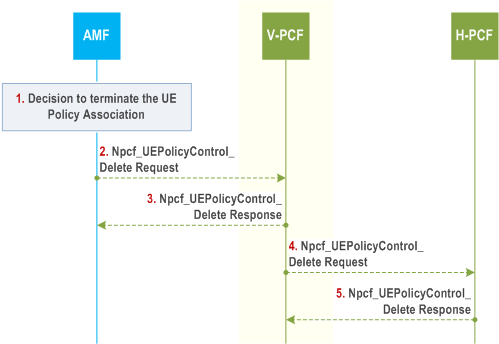
This procedure concerns both roaming and non-roaming scenarios.
In the non-roaming case, the V-PCF is not involved and the role of the H-PCF is performed by the PCF. For the roaming scenarios, the V PCF interacts with the AMF. The V PCF contacts the H-PCF to request removing UE Policy Association.
Step 1.
The AMF decides to terminate the UE Policy Association.
Step 2.
The AMF sends the Npcf_UEPolicyControl_Delete service operation including UE Policy Association ID to the (V-)PCF.
Step 3.
The (V-)PCF removes the policy context for the UE and replies to the AMF with an Acknowledgement including success or failure. The V-PCF may interact with the H-PCF. The (V-)PCF may unsubscribe to subscriber policy data changes with UDR by Nudr_DM_Unsubscribe (Subscription Correlation Id). The AMF removes the UE Policy Context.
If the PCF has previously registered to the BSF as the PCF that is serving this UE, the PCF shall deregister from the BSF if no AM Policy Association for this UE exists anymore. This is performed by using the Nbsf_Management_Deregister service operation, providing the Binding Identifier that was obtained earlier from the BSF when performing the Nbsf_Management_Register service operation.
Step 4 and Step 5 apply only to the roaming case.
Step 4.
The V-PCF sends the Npcf_UEPolicyControl_Delete service operation including UE Policy Association ID to the H-PCF.
Step 5.
The H-PCF removes the policy context for the UE and replies to the V-PCF with an Acknowledgement including success or failure.
Optionally, based on operator policies, as described in clause 6.1.1.4 of TS 23.503, the PCF may store the policy counters and their statuses of spending limits information into the UDR by invoking Nudr_DM_Update .
The H-PCF may unsubscribe to subscriber policy data changes with UDR by Nudr_DM_Unsubscribe (Subscription Correlation Id) for subscriber policy changes. In the non-roaming case, the PCF may unsubscribe to analytics from NWDAF.
The H-PCF may invoke the procedure defined in clause 4.16.8 to unsubscribe to policy counter status reporting or to modify the subscription to policy counter status reporting in CHF (if remaining Policy association for this subscriber requires policy counter status reporting).
4.16.13.2 PCF-initiated UE Policy Association Termination p. 549
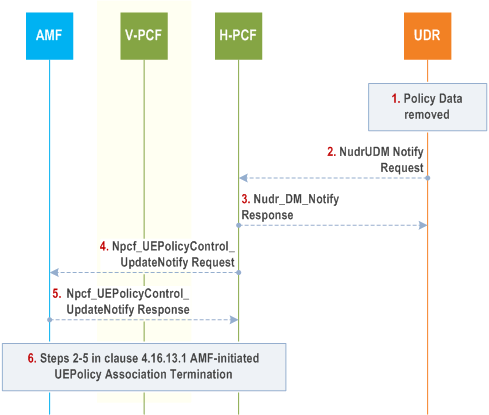
This procedure concerns both roaming and non-roaming scenarios.
In the non-roaming case, the V-PCF is not involved and the role of the H-PCF is performed by the PCF. For the roaming scenarios, the H-PCF interacts with the V-PCF to request removing Policy Association.
The PCF is subscribed to notification of changes in Data Set "Policy Data" for a UE Policy Association ID.
Step 1.
The Policy data is removed, either the Data Set "Policy Data" or the Data Subset "UE context policy control".
Step 2.
The UDR sends the Nudr_DM_Notify_Request (Notification correlation Id, Policy Data, SUPI, UE Context Policy Control data, updated data) including the SUPI, the Data Set Identifier, the Data Subset Identifier and the Updated Data including empty "Policy Data" or empty "UE context policy control".
Step 3.
The PCF sends the Nudr_DM_Notify_Response to confirm reception and the result to UDR.
Step 4.
The PCF may notify the AMF of the removal of the UE Policy Association via Npcf_UEPolicyControl_UpdateNotify service operation. Alternatively, the PCF may decide to maintain the Policy Association if a default profile is applied, in this case steps 4, 5 and 6 are not executed.
In the non-roaming case, the PCF unsubscribes to analytics from NWDAF if any.
Step 5.
The AMF acknowledges the operation.
Step 6.
Steps 2-5 in clause 4.16.13.1 AMF-initiated UE Policy Association Termination are performed to remove the UE Policy Association for this UE and the subscription to Policy Control Request Triggers for that UE Policy Association.